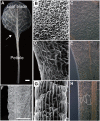Key proliferative activity in the junction between the leaf blade and leaf petiole of Arabidopsis
- PMID: 21880932
- PMCID: PMC3252173
- DOI: 10.1104/pp.111.185066
Key proliferative activity in the junction between the leaf blade and leaf petiole of Arabidopsis
Abstract
Leaves are the most important, fundamental units of organogenesis in plants. Although the basic form of a leaf is clearly divided into the leaf blade and leaf petiole, no study has yet revealed how these are differentiated from a leaf primordium. We analyzed the spatiotemporal pattern of mitotic activity in leaf primordia of Arabidopsis (Arabidopsis thaliana) in detail using molecular markers in combination with clonal analysis. We found that the proliferative zone is established after a short interval following the occurrence of a rod-shaped early leaf primordium; it is separated spatially from the shoot apical meristem and seen at the junction region between the leaf blade and leaf petiole and produces both leaf-blade and leaf-petiole cells. This proliferative region in leaf primordia is marked by activity of the ANGUSTIFOLIA3 (AN3) promoter as a whole and seems to be differentiated into several spatial compartments: activities of the CYCLIN D4;2 promoter and SPATULA enhancer mark parts of it specifically. Detailed analyses of the an3 and blade-on-petiole mutations further support the idea that organogenesis of the leaf blade and leaf petiole is critically dependent on the correct spatial regulation of the proliferative region of leaf primordia. Thus, the proliferative zone of leaf primordia is spatially differentiated and supplies both the leaf-blade and leaf-petiole cells.
Figures








Similar articles
-
The different growth responses of the Arabidopsis thaliana leaf blade and the petiole during shade avoidance are regulated by photoreceptors and sugar.Plant Cell Physiol. 2005 Jan;46(1):213-23. doi: 10.1093/pcp/pci016. Epub 2005 Jan 19. Plant Cell Physiol. 2005. PMID: 15659441
-
The Arabidopsis thaliana rlp mutations revert the ectopic leaf blade formation conferred by activation tagging of the LEP gene.Mol Genet Genomics. 2003 Nov;270(3):243-52. doi: 10.1007/s00438-003-0901-8. Epub 2003 Aug 9. Mol Genet Genomics. 2003. PMID: 12910411
-
The bHLH transcription factor SPATULA controls final leaf size in Arabidopsis thaliana.Plant Cell Physiol. 2010 Feb;51(2):252-61. doi: 10.1093/pcp/pcp184. Epub 2009 Dec 29. Plant Cell Physiol. 2010. PMID: 20040585
-
The leaf meristem enigma: The relationship between the plate meristem and the marginal meristem.Plant Cell. 2021 Oct 11;33(10):3194-3206. doi: 10.1093/plcell/koab190. Plant Cell. 2021. PMID: 34289073 Free PMC article. Review.
-
The developmental context of cell-cycle control in plants.Semin Cell Dev Biol. 2005 Jun;16(3):385-96. doi: 10.1016/j.semcdb.2005.02.004. Semin Cell Dev Biol. 2005. PMID: 15840447 Review.
Cited by
-
Coordination of Leaf Development Across Developmental Axes.Plants (Basel). 2019 Oct 22;8(10):433. doi: 10.3390/plants8100433. Plants (Basel). 2019. PMID: 31652517 Free PMC article. Review.
-
Transcriptomic analysis of contrasting inbred lines and F2 segregant of Chinese cabbage provides valuable information on leaf morphology.Genes Genomics. 2019 Jul;41(7):811-829. doi: 10.1007/s13258-019-00809-7. Epub 2019 Mar 21. Genes Genomics. 2019. PMID: 30900192
-
GROWTH-REGULATING FACTOR 9 negatively regulates arabidopsis leaf growth by controlling ORG3 and restricting cell proliferation in leaf primordia.PLoS Genet. 2018 Jul 9;14(7):e1007484. doi: 10.1371/journal.pgen.1007484. eCollection 2018 Jul. PLoS Genet. 2018. PMID: 29985961 Free PMC article.
-
The ATM-dependent DNA damage response acts as an upstream trigger for compensation in the fas1 mutation during Arabidopsis leaf development.Plant Physiol. 2013 Jun;162(2):831-41. doi: 10.1104/pp.113.216796. Epub 2013 Apr 24. Plant Physiol. 2013. PMID: 23616603 Free PMC article.
-
Heat and chilling stress induce nucleolus morphological changes.J Plant Res. 2019 May;132(3):395-403. doi: 10.1007/s10265-019-01096-9. Epub 2019 Mar 7. J Plant Res. 2019. PMID: 30847615 Free PMC article.
References
-
- Anastasiou E, Kenz S, Gerstung M, MacLean D, Timmer J, Fleck C, Lenhard M. (2007) Control of plant organ size by KLUH/CYP78A5-dependent intercellular signaling. Dev Cell 13: 843–856 - PubMed
-
- Campisi L, Yang Y, Yi Y, Heilig E, Herman B, Cassista AJ, Allen DW, Xiang H, Jack T. (1999) Generation of enhancer trap lines in Arabidopsis and characterization of expression patterns in the inflorescence. Plant J 17: 699–707 - PubMed
-
- Clough SJ, Bent AF. (1998) Floral dip: a simplified method for Agrobacterium-mediated transformation of Arabidopsis thaliana. Plant J 16: 735–743 - PubMed
-
- Dengler NG, Tsukaya H. (2001) Leaf morphogenesis in dicotyledons: current issues. Int J Plant Sci 162: 459–464
Publication types
MeSH terms
Substances
LinkOut - more resources
Full Text Sources
Molecular Biology Databases

